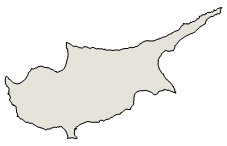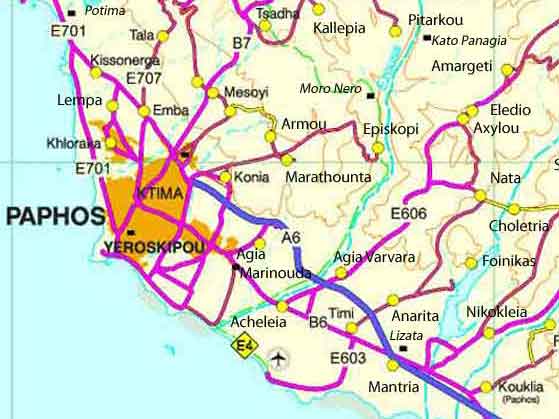.



Emba or Empa (Greek: Έμπα) is one of the biggest villages in Paphos. Its spread over a wide area it not only borders Paphos but also the villages Chloraka, Kissonerga, Tala, Tremithousa and Mesogi.
| Year | Population |
| 1946 |
760 |
| 1960 | 1027 |
| 1982 | 1175 |
| 1992 | 2069 |
| 2001 | 3664 |
The village already existed by the Byzantine era and it is known from the Frankish rule with the same name. The Cypriot historian Leontios Machairas, (15th century) in his Chronicle, par. 129, denotes a visit of king of Cyprus Peter I (1359 - 1369) quoting "...and the king went hunting and reached Emba towards Paphos...".
Louis de Mas Latrie includes the village amongst those that belonged, during Frankish rule, to the family of the king of Cyprus, and moreover, as one of the kings villages that cultivated sugarcanes. Since 1468 the village, alongside with many others, fell under the region of Chrysochous, under the regional law officer (bailIiage).
The appellation of the village is purely Greek, belonging to the Cypriot dialect: Emba, in the Cypriot dialect means enter. It is possible that the name of the village was given because it is built at the entrance of Paphos, that is the edges of the city, through which the travellers from the north, northwest and west came in. Another version mentions that the name was given to the village because it is situated near the coast from where people departed from or arrived to Cyprus by sea, during the Byzantine era or even later during the Frankish rule. It is relevantly mentioned that King Peter I had departed for Europe, from the area in 1362. The village is noted as "Enba" in medieval maps.
In the Community you can find the ancient church of Panayia Chryseleoussis. Built at the 12th Century in Byzantine Rhythm, it embellishes literally the village Square. Almost all the walls in the interior of Church are covered by murals certain of them priceless for their religious and historical value as that of Pantokratoros and that of Saint George that you find next in the pulpit which dates around in the 13th century. Appreciable is also the fretworked gold plated iconostasis of 16th of century which adorn the ancient pictures Jesus of Virgin Mary and saint John Precursor. In the church is also found a Gospel from the 16th century, which was printed in Venice. Thousands of tourists visit the church each year to admire its architecture and the wonders it contains. There are also a number of chapels in Emba such as the Byzantine chapel decicated to Saint George (at the vicinity of Petridia),the cave chapel of Saint Limbros(also at Petridia), and the new chapel dedicated to Saint Haralambos.At Pedridia,in older times there was also the church of Saint Akakios build on land which was a depenancy of the Monastery of Stavros at the village of Omodos.The other chapels of Emba now in ruins are the following:The Chapel of Saint Eleftherios,the Chapel of All Saints(Ayioi Pantes),the Chapel of Timios Prodromos,the Chapel of Saint Sofronios,the Chapel of Saint Mercurios,the Chapel of the Five Saints(Ayioi Pente: Efstratios, Afxentios, Evgenios, Mardarios, Orestis), the Chapel of Saint Paraskevi and the Cave of Saint Kournoutas at Pertidia.
Recently a new church was constructed near the old one it was dedicated to the apostle Andreas (St. Andrew) and on his name day, 30th November, a religious festival is held on the church grounds. Apart from this very new church there are also many small chapels scattered around the rest of the village.
Emba has a few shops and tavernas dotted along the narrow winding road that runs through the village.In the evening the local men can be seen sitting outside their local and often spilling out onto the narrow roads on their wooden chairs.
Outstanding personalities of the village of Emba enclude the following: The Bishop of Irinoupolis(situated then in the Middle East) was born at the village of Emba (date unknown)and died in 1791. Father Christodoulos (1816) a great priest of the village.
Community Council President: Antonis Nikiforou
Images Cyprus, Paphos District

| Ancient Greece
Science, Technology , Medicine , Warfare, , Biographies , Life , Cities/Places/Maps , Arts , Literature , Philosophy ,Olympics, Mythology , History , Images Medieval Greece / Byzantine Empire Science, Technology, Arts, , Warfare , Literature, Biographies, Icons, History Modern Greece Cities, Islands, Regions, Fauna/Flora ,Biographies , History , Warfare, Science/Technology, Literature, Music , Arts , Film/Actors , Sport , Fashion --- |
Retrieved from "http://en.wikipedia.org/"
All text is available under the terms of the GNU Free Documentation License

